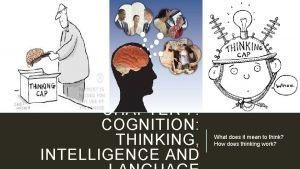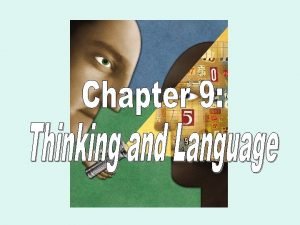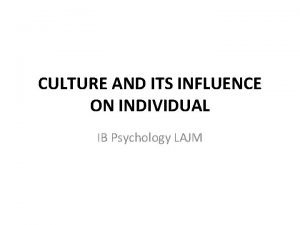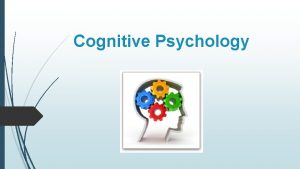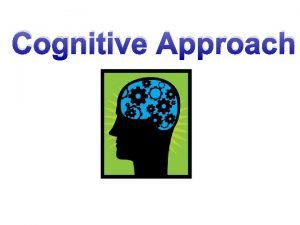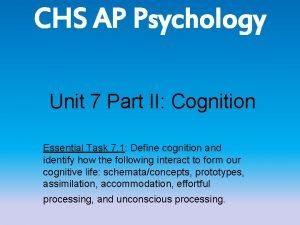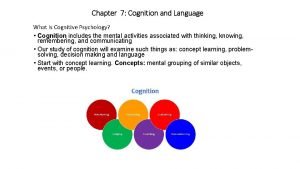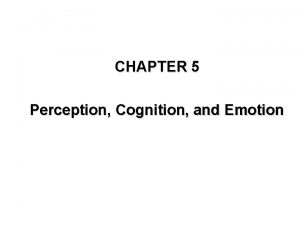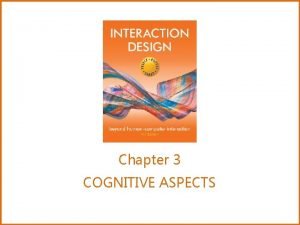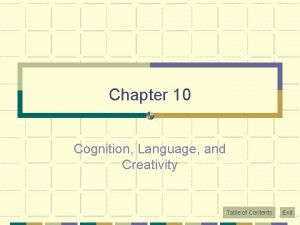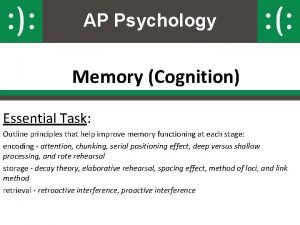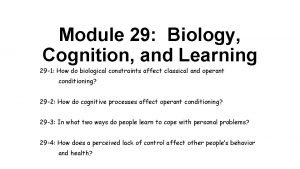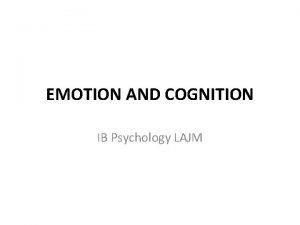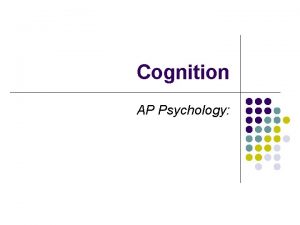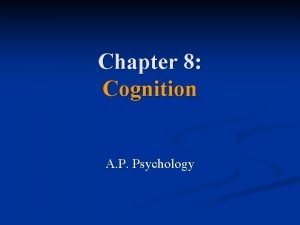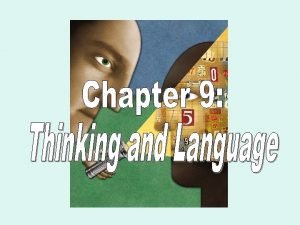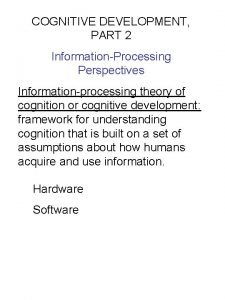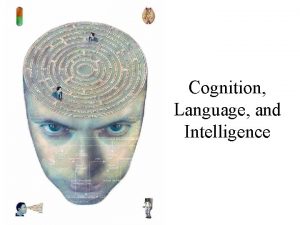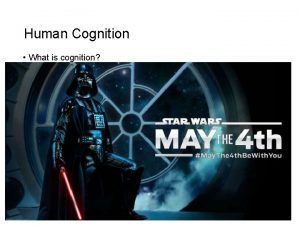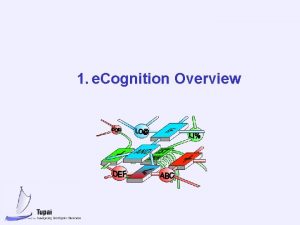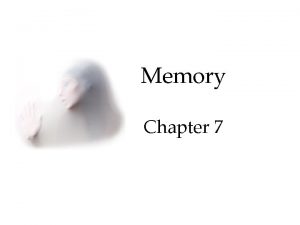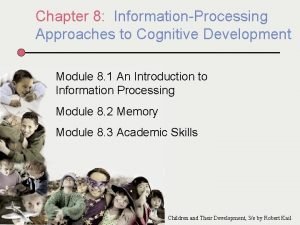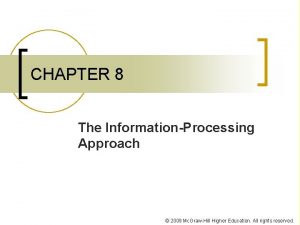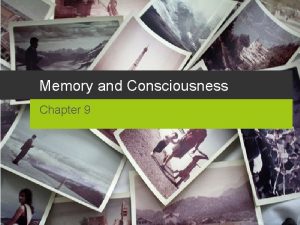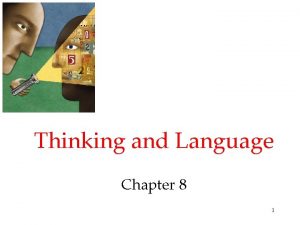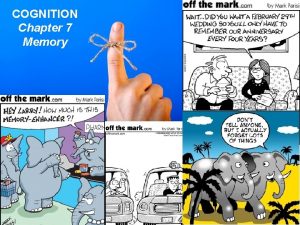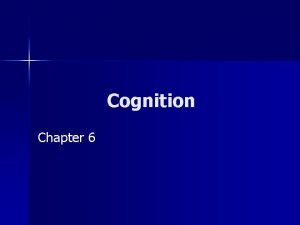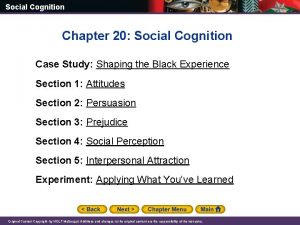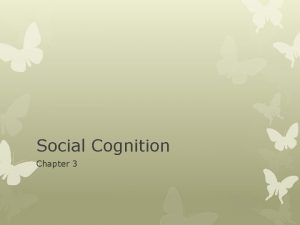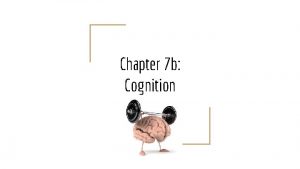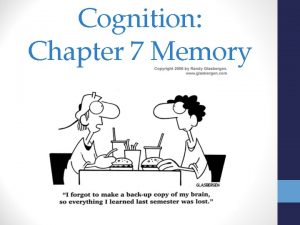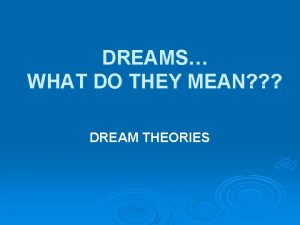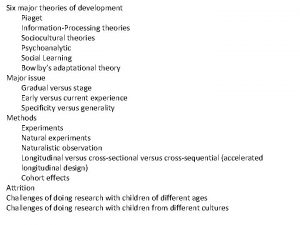CHAPTER 7 8 OVERVIEW CHAPTER 7 COGNITION INFORMATIONPROCESSING






















- Slides: 22

CHAPTER 7 & 8 OVERVIEW

CHAPTER 7 COGNITION

INFORMATION-PROCESSING MODEL Encoding The processing of information into the memory systems Storage The retention of encoded information over time Retrieval The process of getting information out of memory storage The processing of many aspects of a problem is known as parallel processing Atkinson-Shiffrin Three-Stage Model Sensory memory Short-term memory and Working Memory Long-term memory


ENCODING Explicit memories(facts) this is done through effortful processing Implicit memories(skills) which are automatically processed Ebbinghaus curve The more time taken to learn something the less time you will need to relearn it in the future Ebbinghaus’ forgetting curve forgetting is initially rapid, then levels off with time Iconic memory-sensory memory of visual stimuli Echoic memory-sensory memory of auditory stimuli(lasts longer)


PRACTICE AND APPLICATION OF MEMORY Mnemonic devices, chunking, and hierarchies all help to retrieve information Testing Effect More likely to retain information if you are consistently tested/quizzed on it Serial position effect Our tendency to recall best the last and first items in a list Flashbulb memory A clear memory of an emotionally significant moment or event

MEMORY LOSS/STRUGGLES Amnesia loss of memory Retrograde(long-term) A loss of memory- access to events that occurred Anterograde(short-term) Inability to create new memories Encoding Failures(correct penny) Retrieval Failure Information is not forgotten it is stored, but if un-retrieved it came become almost blurry “Tip of my tongue phenomenon” Retroactive Interference New information blocks out old information Proactive Interference Old information blocks out new information

MEMORY CONSTRUCTION ERRORS Loftus memory studies Misinformation effect Incorporating misleading information into one’s memory of an event “Smash” vs “bumped” when describing an accident Source amnesia (source misattribution) Attributing to the wrong source an event we have experienced/heard about Helps to explain déjà vu which is a "mix-up" between sensory input and memory-recalling output

THINKING AND CONCEPTS Concepts Category hierarchies or groupings Prototype Can one bird be more “birdy” than another? Convergent thinking vs Divergent thinking Problem Solving Strategies Trial and error Algorithms Step-by-step Heuristic A simple thinking strategy that often allows us to make judgments and solve problems Insight Sudden realization

FORMING GOOD AND BAD JUDGEMENTS Intuition an effortless, immediate, automatic feeling or thought, as contrasted with explicit, conscious reasoning The Representative Heuristic judging the likelihood of things in terms of how well they seem to represent, or match The Availability Heuristic Estimating the likelihood of events based on their availability in memory Overconfidence we overestimate our ability

LANGUAGE Phoneme In language, the smallest distinctive sound unit English about 40 phonemes Morpheme A meaningful linguistic unit consisting of a word, such as boy Includes prefixes and suffixes, such as boy(s) Grammar a system of rules that enables us to communicate with and understand others

LANGUAGE Language Development Babbling stage- 4 months One-word stage- 12 months Two-word stage(Telegraphic speech)- 24 months After 24 months language tends to develop consistently Chomsky: Inborn Universal Grammar Language acquisition device Given adequate nurture, language will occur Universal grammar All humans have the same basic building blocks, nouns, verbs Overgeneralization of grammar rules Whorf’s Linguistic Determinism The idea that language determines the way we think

CHAPTER 8 MOTIVATION, EMOTION AND STRESS

MOTIVATION-A NEED OR DESIRE THAT ENERGIZES AND DIRECTS BEHAVIOR Drive-reduction theory a physiological need creates an aroused tension state (a drive) that motivates an organism to satisfy the need Need(Food) Drive(hunger) Drive reduction(eat) Optimum level of arousal-motivated behaviors may increase or decrease based on arousal Yerkes-Dodson Law moderate arousal will led to optimal performance, but beyond that performance decreases Maslow’s hierarchy of needs-We must satisfy the bottom parts of the pyramid before we move on to



THEORIES OF EMOTION James-Lange theory our experience of emotion is our awareness of our physiological responses to emotionarousing stimuli Stimulus CNS automatic response= emotion Cannon-Bard theory an emotion-arousing stimulus simultaneously triggers (1) physiological responses and (2) the subjective experience of emotion. Stimulus= CNS automatic reaction AND emotion SIMULTANEOSULY Two-factor theory(Schachter-Singer theory) to experience emotion one must (1) be physically aroused and (2) cognitively label the arousal Stimulus CNS automatic response + cognitive label= emotion


EXPRESSING EMOTION As humans a majority of our communication occurs non-verbally, from a firm handshake to a hug Women also have greater emotional literacy, which also may contribute to their greater emotional responsiveness Facial feedback This is the tendency of facial muscles to actually influence or trigger the corresponding feeling such as happiness or anger

STRESS Stressors in life Catastrophes unpredictable, large-scale events Significant life changes life transitions Daily hassles events that do not change our lives but create a hassle Selye’s General adaptation syndrome (GAS) Phase 1 Alarm Phase 2 Resistance Phase 3 Exhaustion The human body deals well with temporary stress, but prolonged stress can damage it Type A versus Type B-individuals

 Chapter 7 cognition thinking intelligence and language
Chapter 7 cognition thinking intelligence and language Chapter 7 quiz cognition thinking intelligence and language
Chapter 7 quiz cognition thinking intelligence and language Belief perseverance
Belief perseverance Loose associations thought process
Loose associations thought process Mse in counseling
Mse in counseling Odden and rochat
Odden and rochat What is cognition
What is cognition Cognition definition
Cognition definition Mental set ap psychology
Mental set ap psychology What is cognition
What is cognition Types perception
Types perception Altered cognition in older adults is commonly attributed to
Altered cognition in older adults is commonly attributed to What is cognition
What is cognition Cognition definition
Cognition definition Chunking ap psychology examples
Chunking ap psychology examples Unit 7 cognition ap psychology
Unit 7 cognition ap psychology Module 29 biology cognition and learning
Module 29 biology cognition and learning Limited social cognition
Limited social cognition Teacup ib psychology
Teacup ib psychology Unlike b.f. skinner, noam chomsky believes that children
Unlike b.f. skinner, noam chomsky believes that children Belief bias ap psychology
Belief bias ap psychology Embodied cognition ap psychology
Embodied cognition ap psychology Cognition refers to
Cognition refers to

